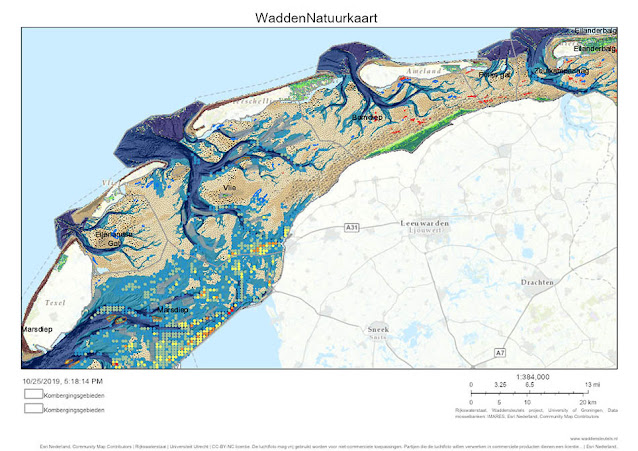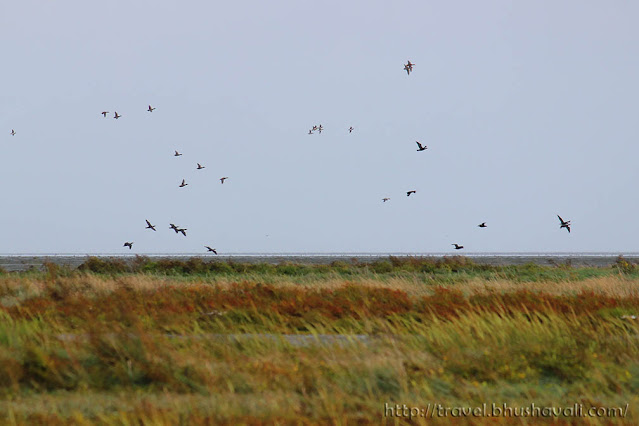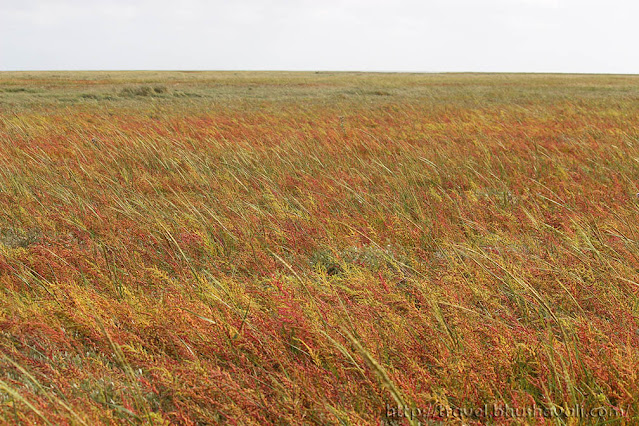The main reason why we headed to Texel Island, Netherlands was ofcourse for Wadden Sea which is one of the UNESCO World Heritage Sites in Netherlands! Well actually, its a shared site with Germany and Denmark as well. Wadden Sea is the world's largest unbroken system of inter-tidal sand and mud flats. Its something like marsh land, but saltwater marsh, and a bit more complex than just a marsh.
It forms the shore of the several bits & pieces of little islands scattered in a line, in the north of Netherlands, Germany and west of Denmark. To the inner side of these islands is the Wadden Sea and the outer side is the North Sea. The terrain image below would give a better idea of the depths of sea. The white parts in the image are land masses & islands.
See how the tidal channels come in, from North Sea, between the islands & spread and branch out in the Wadden sea, in the pic above? Because of this geography, this region has land, beaches, shallow sea between tidal channels, sea-grass meadows, mussel beds, mudflats, salt marshes, estuaries, and dunes. As I said, salt-marshes is just one of the several coastal-life habitats that the region has. Most of the western coast of the Texel island is a part of this unique eco-system and we stopped over at 2 - De Schorren and De Stufter. While exploring these regions is completely possible by yourself, unless you're a pro-birder or naturalist, I'd definitely recommend to join one of the eco-walks. There is so much of ecology here (obviously, which is why its listed by UNESCO!), that unless you are or go with an expert, you may not know what you're seeing!
Bird watching is such an important activity in the island that there are bird watching huts called Vogelkijkhuts, located at about 35 places! Several bird watching tours happen all over the island, all over the year. Also the tourism office has a checklist of the birds that you could spot, like literally a paper form list with names of birds & check boxes that you could carry while going on a bird watching walk/tour.
GUIDED TOUR OF DE SCHORREN - UNUSUAL THINGS TO DO IN NETHERLANDS
While there are many organizations that conduct various tours, Natuurmonumenten is the government agency that protects these regions and they also organize some tours. With the time we had, we chose to go on the guided tour on De Schorren only. Our guide was this absolutely amazing lady with a lots of knowledge and experience, Ms. Ava! It was 2.5hrs long and she was a bubble of energy!She explained us everything, starting from the algae of the region. To begin with there is wantide in this region. What is a wantide? That's the region between 2 islands where depth is less and the tides of both Wadden Sea and North Sea meet. In this region, the mini organisms that normally float on the sea, like algae, sink! This entire sea-bed, which is shallow, is filled with these algae and this is really yummy for the birds!!! When I say filled with algae, don't under estimate it. The 2nd picture below is not a piece of polythene, its algae....
Some of the marine animals that can be spotted here include slangster (looks like a starfish but with long arms), flat fishes like plaice fish etc. Then ofcourse, on top of this food chain are the seals! On a sunny day, its possible to see many seals sunbathing in the beaches. With the rains when we went, we didn't manage to spot even one. If you have enough time, one amazing things to do would be to go seal watching on a boat, which also takes you around the uninhabited island of Nooderhanks where seal spotting is almost definite!
There are view points at quite a few places, and we stopped at the one in De Stufter. The landscape is similar to De Schorren and we didn't go inside or wander these marshes.
- Wear wellington boots or knee-high waders. Yeah, most of the participants wore sneakers and we did too! The shoes were gone and we were muddy till the knee!
- Binoculars is a good idea.
- While camera with large tele-lens may seem like a good idea, in reality it isn't! The mid-flats are very slippery and some participants actually fell down and had to be helped to get up. Your camera 'may' get very very dirty if it falls into the marshes!
TEXEL ISLAND CAMPING & HOTELS
Hotels & BnBs at all price points are available in Texel. Several camping grounds & beach huts are also available if you're a bit adventurous. Check out my Bos en Duin Appartmentenhotel review where we stayed.
HOW TO REACH DE SCHRORREN IN TEXEL ISLAND
On Google Maps: De Schorren, De Stufter
Both are served only by the Texelhopper shuttle van and not the main line-28.
Alternatively ofcourse you can choose to cycle!
While the marshes are open to public 24x7, the best times to go for birdwatching are dawn & dusk.
The guided tour by Natuurmomenten happens in the evening 2:00-4:30 or 2:30-5:00.
The number of tickets is limited. So pre-booking via their website is necessary.
Price: € 8.00; The lowest age to participate is 8 years of age.
MY COMPLETE TEXEL TRAVELOGUE
The guided tour by Natuurmomenten happens in the evening 2:00-4:30 or 2:30-5:00.
The number of tickets is limited. So pre-booking via their website is necessary.
Price: € 8.00; The lowest age to participate is 8 years of age.
MY COMPLETE TEXEL TRAVELOGUE
Top 5 things to do in Texel, Wadden Sea UNESCO World Heritage, Villages of Texel Island, Cycling around Texel Island
P.S: I was invited by VVV Texel Tourism to experience the region for review purposes, however the opinions are my own and this post does not to advertise the product/service.
P.S: I was invited by VVV Texel Tourism to experience the region for review purposes, however the opinions are my own and this post does not to advertise the product/service.

























I actually have never heard of Wadden Sea even though it is a UNESCO site. But it does sound interesting. Thanks for the recommendation to visit with an expert on an eco walk. I am sure we would learn much more than on our own. It would be fun to visit on a sunny day when the seals are out. But I will remember to wear rain boots!
ReplyDeleteWarden Sea sounds amazing! I would love to see some of the marine animals, especially the seals! Thanks for the tip about wearing waders!
ReplyDeleteThis is interesting. I have never joined an eco-walk (probably because it is not common here in the Philippines) but I am interested in exploring nature and it helps if there's an expert to explain what I am seeing.
ReplyDeleteThough we do not have immediate plans of visiting Netherlands soon, I am happy to read more about the Wadden Sea. I learned something new today. Happy to know too that UNESCO declared it as a world heritage site.
oh WOW - Half of my extended family lives in the Netherlands, but as many times as I have been there, never visited this. Next time I go, I am going to make them take me there. Thanks for the tips on the footwear so I can keep my feet dry:)
ReplyDeleteJoining an eco-walk sounds fun and I never even knew that was a thing. What an experience this must've been! Love that there are government agencies that protect these regions and organize tours accordingly too.
ReplyDeleteGood to know about Wadden Sea in Netherlands which is a UNESCO World Heritage Site and that too shared site with Germany and Denmark as well. I never knew that Wadden Sea is the world's largest unbroken system of inter-tidal sand and mud flats and therefore it has marshy grasslands I believe. So is it like delta or Gulf? Algae really looks like polythene and with first glance, I thought you picked up some big leaf or polythene.
ReplyDeleteThis post is so enriching. I didn't have any idea Sea about Waddens which is world's largest unbroken system of inter-tidal sand and mud flats. I would definitely love to explore it. I am just imagining the birding scene there. On my list now. Thank you.
ReplyDeleteThanks for a great post! It's the first time I've heared about Texel and Wadden Sea. I had no idea that Neatherlands has so much to offer in some less touristic places! Sounds like you had a really amazing experience there, although it's quite sad that you didn't get to see the seals, maybe next time?
ReplyDeleteIn my opinion, this is one of the most beautiful areas in the Netherlands. We used to go to on family vacations on Texel all the time. The nature is pristine and the wildlife is so plentyful! I love hiking the dunes and in the summer, the beaches are great.
ReplyDeleteNever knew of this interesting UNESCO site that is shared by Germany and Denmark. It would have been interesting experience to explore the Wadden Sea learning about the surrounding geography along with bird watching and sightings of marine animals. Walking on marsh land could be fun but with a fall in to it, would be lot of cleaning work afterwards though.
ReplyDeleteI hadn’t heard about Texel or Wadden Sea so was pleasantly surprised to learn that it is a UNESCO heritage site when I read this informative post. The image of the map you’ve included really helps gain perspective of just how extensive this region is and how the tidal channels come in. As you’ve suggested, to make the most of the experience and learn about the ecology I would love to take a guided eco-walk and the bird watching tour as well. Thanks for the tips regarding wearing boots and being mindful regarding the type of camera to be taken to this trip.
ReplyDeleteIt's always such a joy to learn about the beautiful destinations you visit, Bhushavali! I had no idea the coast of the Netherlands had so much unspoiled natural beauty. The multicolored plant life in the area is beautiful and bird watching with an expert guide sounds like the perfect way to do it. I would love to visit Texel and the surrounding area someday soon. Thanks for sharing!
ReplyDelete